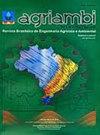Efficiency of anti-vibration gloves in soil preparation using a micro tractor
IF 1.4
4区 农林科学
Q3 AGRICULTURAL ENGINEERING
Revista Brasileira de Engenharia Agricola e Ambiental
Pub Date : 2020-01-01
DOI:10.1590/1807-1929/agriambi.v24n6p422-427
引用次数: 1
Abstract
ABSTRACT During the working day, agricultural machinery operators are often exposed to physical risks, such as vibration, which can compromise their health and performance. Micro tractors emit high levels of vibration, which mainly affect their hands and arms. Thus, this study aims at evaluating the efficiency of different glove models in reducing vibration transmitted by the micro tractor/rotary tiller assembly according to the operating velocity and the rotation of the rotary tiller rotor. A completely randomized block design was used in a 4 x 2 x 2 factorial arrangement with five replicates. The study analyzed three glove models (G1 and G2 anti-vibration models, and anti-impact model G3) and a control treatment under the same operating conditions, but without the use of protective equipment. The study was conducted at two operating velocities (V1 = 0.98 km h-1 and V2 = 1.6 km h-1) and two rotations of the rotary tiller rotor (R1 = 265 rpm and R2 = 520 rpm). None of the evaluated glove models reached the attenuation capacity required by the Occupational Hygiene Standard (Norma de Higiene Ocupacional - NHO 10) and, under some operating conditions, they raised the incident vibration levels, exceeding the values obtained when the work was performed without a protective equipment. Although the anti-impact model G3 and the anti-vibration model G2 did not reduce the transmitted vibration to the levels considered acceptable by NHO 10, the anti-impact G3 and anti-vibration G2 models showed better performance in the work performed at a velocity of 0.98 km h-1 and a rotation of 520 rpm of the rotary tiller rotor.微型拖拉机整地防振手套的效能研究
在工作中,农机操作人员经常面临振动等物理风险,这些风险会损害他们的健康和工作效率。微型拖拉机发出强烈的振动,主要影响他们的手和手臂。因此,本研究旨在根据旋耕机转子的运行速度和转动情况,评估不同手套型号对微拖拉机/旋耕机总成传递振动的降低效率。采用完全随机区组设计,采用4 × 2 × 2因子排列,共5个重复。本研究分析了三种手套模型(G1和G2抗振动模型,G3抗冲击模型)和相同操作条件下的对照处理,但不使用防护设备。研究采用两种操作速度(V1 = 0.98 km h-1, V2 = 1.6 km h-1)和旋耕机转子两种转速(R1 = 265 rpm, R2 = 520 rpm)。所评估的手套模型均未达到职业卫生标准(职业卫生规范- NHO 10)所要求的衰减能力,并且在某些操作条件下,它们提高了事故振动水平,超过了在没有防护设备的情况下进行工作时获得的值。虽然抗冲击模型G3和抗振动模型G2没有将传递振动降低到NHO 10可接受的水平,但抗冲击模型G3和抗振动模型G2在旋耕机旋翼转速为520rpm、转速为0.98 km h-1时的工作表现较好。
本文章由计算机程序翻译,如有差异,请以英文原文为准。
求助全文
约1分钟内获得全文
求助全文
来源期刊

Revista Brasileira de Engenharia Agricola e Ambiental
Agricultural and Biological Sciences-Agronomy and Crop Science
CiteScore
2.70
自引率
16.70%
发文量
114
审稿时长
3-8 weeks
期刊介绍:
A Revista Brasileira de Engenharia Agrícola e Ambiental (Agriambi), periódico oficial da Asociación Latinoamericana y del Caribe de Ingeniería Agrícola (ALIA), é editada mensalmente, no formato eletrônico, pela Unidade Acadêmica de Engenharia Agrícola (UAEA) do Centro de Tecnologia e Recursos Naturais (CTRN) da Universidade Federal de Campina Grande (UFCG), destinando-se à divulgação de artigos científicos originais e inéditos, elaborados em Português, Inglês ou Espanhol. Com o auxílio de pareceres de Consultores, os artigos são aceitos ou não pela Equipe Editorial para publicação na Revista. A Agriambi aceita, também, a submissão de contribuições na modalidade de revisão de literatura.
 求助内容:
求助内容: 应助结果提醒方式:
应助结果提醒方式:


